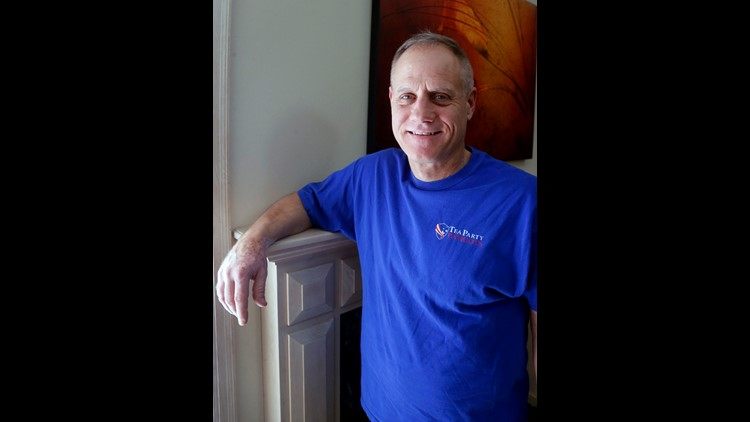U.S. Supreme Court strikes down
Minnesota dress code for voters

he U.S. Supreme Court struck down a Minnesota law Thursday that prohibited voters [from wearing political buttons and apparel] when they cast ballots.
In a 7-2 decision, the high court revoked a century-old Minnesota law that barred voters from wearing politically affiliated clothing at polling places.
The ban covered all articles of clothing and accessories that contained a political insignia or message. Violators were subject to a fine or petty misdemeanor charge.
Clothing that speaks to an issue on the ballot or promotes a group with recognizable political views are also banned. Examples include a National Rifle Association T-shirt or one with the text of the Second Amendment.
The state said its approach preserved order and decorum at polling places and helped prevent voter intimidation.
The challengers, citing the First Amendment, said [the law is too vague – that] the state should not be able to prohibit such a broad swath of politically expressive clothing.
Andy Cilek holds a second Tea Party tshirt outside the US Supreme Court.
Chief Justice John Roberts, writing for the court, said Minnesota’s law was vague and open to confusion at times, and noted it must be guided by workable and objective standards.
“Without them, an election judge’s own politics may shape his views on what counts as ‘political.’ And if voters experience or witness episodes of unfair or inconsistent enforcement of the ban, the State’s interest in maintaining a polling place free of distraction and disruption would be undermined by the very measure intended to further it,” Roberts wrote.
Most states have laws restricting what voters can wear when they cast ballots, but Minnesota’s law was one of the broadest. It barred voters from casting a ballot while wearing clothing with the name of a candidate or political party. Also not allowed: clothing that references an issue on the ballot or promotes a group with recognizable political views. Delaware, Kansas, Montana, New Jersey, New York, South Carolina, Tennessee, Texas and Vermont all have similar laws to Minnesota’s. South Carolina also has a restriction, but it applies only to what can be worn inside the polling place by candidates themselves, not voters.
“Minnesota, like other states, has sought to strike the balance in a way that affords the voter the opportunity to exercise his civic duty in a setting removed from the clamor and din of electioneering,” Roberts wrote. “While that choice is generally worthy of our respect, Minnesota has not supported its good intentions with a law capable of reasoned application.”
Roberts noted the broad definition of the law could ban a t-shirt that simply said “Vote!” or a t-shirt saying “Support our Troops” or “#MeToo.”
Justice Sonia Sotomayor, joined by Stephen Breyer in the dissenting opinion, argued there was no evidence the Minnesota statute was interpreted or applied in an unreasonable manner.
“There is no evidence that any individual who refused to remove a political item has been prohibited from voting, and respondents maintain that no one has been referred for prosecution for violating the provision,” Sotomayor wrote.
The case was brought to the court by Andrew Cilek, who went to a polling place in 2010 wearing a shirt with a Tea Party logo and the words “Don’t Tread on Me” on it, as well as a button with the words “Please I.D. Me,” a reference to legislation then under discussion in Minnesota that would have required residents to show photo identification to vote. The legislation ultimately didn’t become law.
Election workers initially stopped Mr. Cilek from casting a ballot, telling him he must remove his t-shirt and button. [He changed his shirt a few times – to others deemed unacceptable by the poll workers, and after taking down his name and address for potential prosecution], they eventually let him vote.
“If you showed 20 election judges various logos and T-shirts and asked them if they were allowed under the statute, you’d get 20 different answers,” Cilek said.
The Supreme Court has previously backed some restrictions on voters’ free speech rights at the polls. In 1992, the court upheld a Tennessee statute prohibiting the display or distribution of campaign materials within 100 feet of a polling place.
The case decided Thursday is 16-1435 Minnesota Voters Alliance v. Mansky.
From UPI with excerpts from The Wall Street Journal and Boston Herald, June 14. Reprinted here for educational purposes only. May not be reproduced on other websites without permission from UPI .com.
Article Source:https://www.studentnewsdaily.com/daily-news-article/u-s-supreme-court-strikes-down-minnesota-dress-code-for-voters/
ImageSource:www.studentnewsdaily.com/wp-content/uploads/2018/06/andy-cilek.jpg" class="img-thumbnail" alt="U.S. Supreme Court strikes down Minnesota dress code for voters
VOCABULARY WORDS
1.Politically/: in a way that relates to the government or public affairs of a country.
2.Affiliated/adjective: (of a subsidiary group or a person) officially attached or connected to an organization.
3.Misdemeanor/noun: a minor wrongdoing.
4.Amendment/noun:a minor change in a document
a change or addition to a legal or statutory document.
5.Decorum/noun: behavior in keeping with good taste and propriety.
6.Intimidation/noun: the action of intimidating someone, or the state of being intimidated.
7.Prohibit/verb: prohibit; formally forbid (something) by law, rule, or other authority.
QUESTIONS FOR DISCUSSION
1. a) Describe the Minnesota law the U.S. Supreme Court ruled unconstitutional on Thursday. Be specific. (see para. 1-4, 9)
b) What is the penalty for violating the Minnesota voter apparel law?
2. How did the state defend the law?
3. On what grounds did the plaintiffs challenge the law?
4. How did Chief Justice John Roberts explain the majority opinion? (see pare. 7-8, 10-11)
5. How many states have similar laws? List the states.